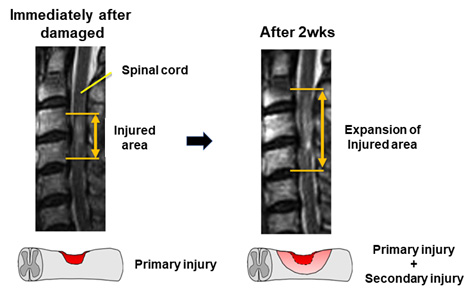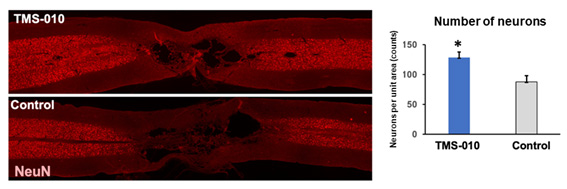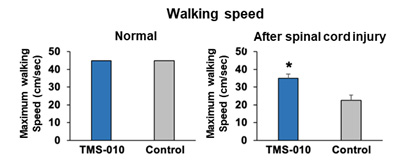Spinal cord is inside spine, functions like a thick bundle of nerves that transmit signals necessary for moving hands, walking, and feeling pain and numbness, between brain and peripheral nerves. When spine is fractured or dislodged due to strong external force, spinal cord is also damaged which could lead to serious neurological impairments such as motor and sensory paralysis, and excretory disorders1). Although it occurs in approximately 5,000 patients per year in Japan2) and approximately 180,000 patients per year worldwide3), no effective drug remains to be approved. Currently, an intravenous administration of steroid is approved as the standard of care, but it is difficult to say that the treatment is necessarily effective enough, thus demanding new therapeutic agents.
After the spinal cord is injured, the damaged area is getting expanded for about two weeks.4) This pathological phenomenon is called secondary injury, and the disruption of blood-brain spinal cord barrier (BBSCB) is one of the causes (Fig. 1). TMS-010 is identified at Hokkaido University as a candidate for the treatment of spinal cord injury and expected to exhibit a neuroprotective effect by ameliorating the secondary injury through preventing the disruption of the BBSCB. A series of nonclinical studies conducted by Hokkaido University and our company revealed the various effects such as a reduction in the cavity area at the injured site (Fig. 2), an increase in the number of survived neurons (Fig. 3), and an improvement of motor function (Fig. 4).

- 拡大
- Fig. 1 Expand of damaged area with secondary injury.

- 拡大
- Fig. 2 Spinal cord injury area at cervical level after TMS-010 administration.
TMS-010 administration resulted in a decrease in cavity area.
(Graphs are means ± SEM, n = 8, * p<0.05)

- 拡大
- Fig. 3 Neurons near the area of spinal cord injury site at the thoracic level.
The number of neurons, indicated by the red bright dots, was increased by TMS-010 administration.
(Graph shows mean ± SEM of the number of neurons within 4 mm above and below the injured area, n=10, * p<0.05)

- 拡大
- Fig. 4 Maximum walking speed after cervical spinal cord injury.
TMS-010 administration significantly increased the maximum walking speed.
(Graphs are mean + SEM, n = 8, * p<0.05)
By proceeding with the development, manufacture, and marketing of TMS-010 as a treatment for spinal cord injury by our company, we are expecting to provide a new treatment option for spinal cord injury not only in Japan but also around the world, where no effective drug therapy has been available.
References
- Neurospinal Society of Japan, website (https://www.neurospine.jp/original62.html, in Japanese)
- Miyakoshi N, et al. A nationwide survey on the incidence and characteristics of traumatic spinal cord injury in Japan in 2018. Spinal Cord 59(6), 626-634 (2021)
- Lee BB., et al. The global map for traumatic spinal cord injury epidemiology: update 2011, global incidence rate. Spinal Cord 52(2), 110-116 (2014)
- Ahuja CS, et al. Traumatic spinal cord injury. Nat Rev Dis Primers. 27(3), 17018 (2017)